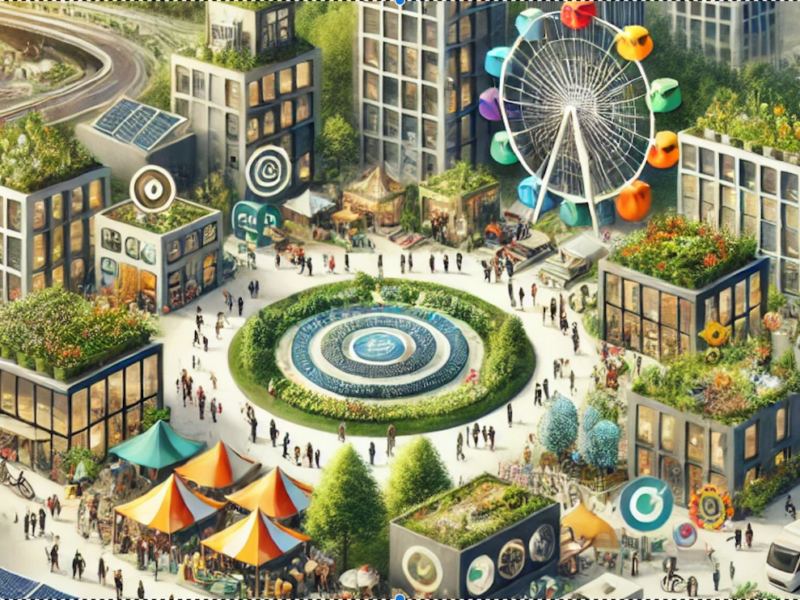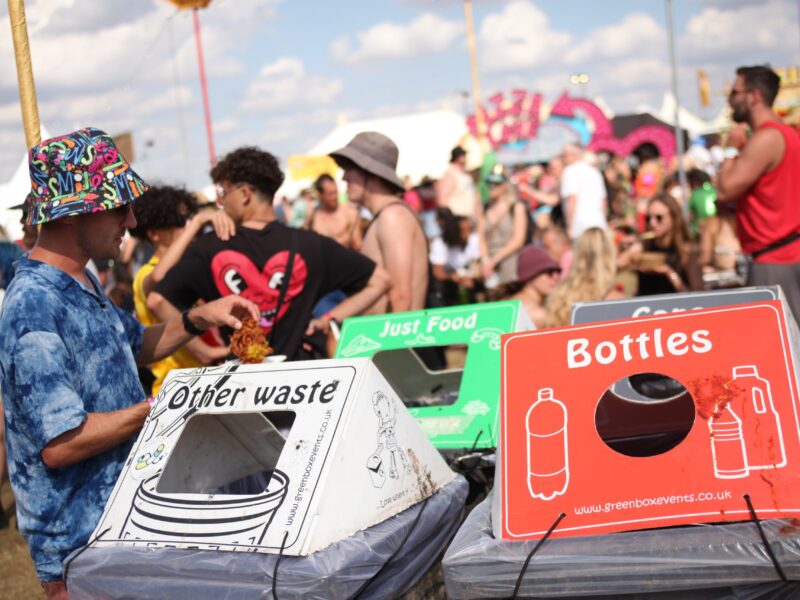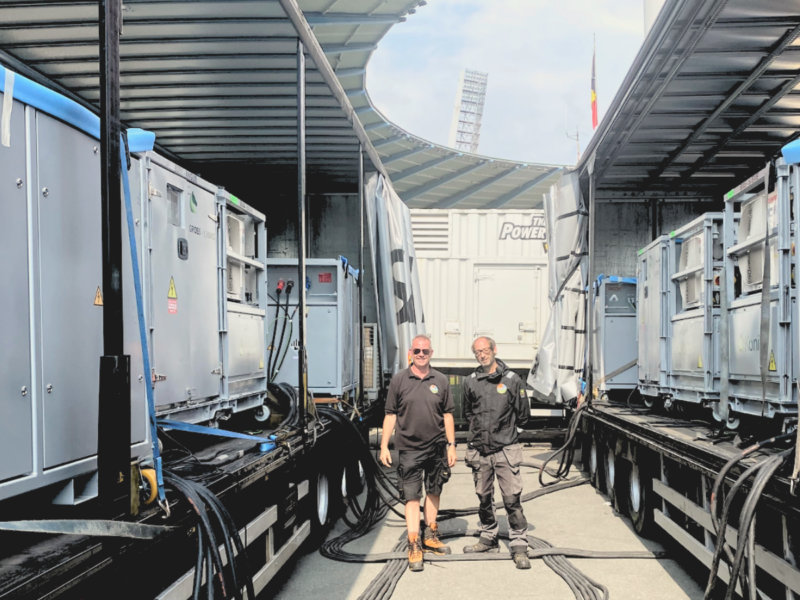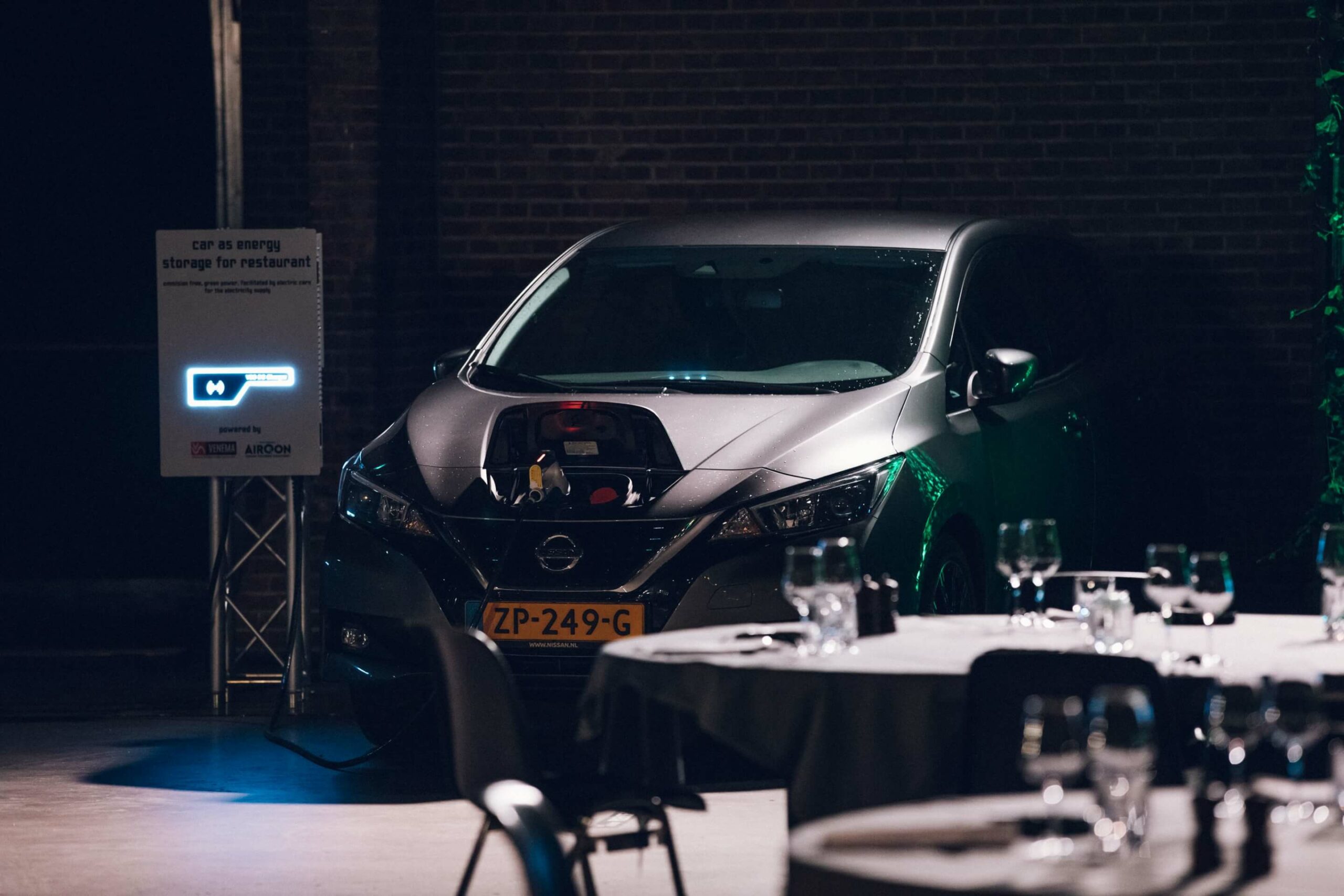
Renewable Trias Energetica: The path to emission free, renewable energy at your event.
The Trias Energetica was developed in 1979 by Delft University of Technology and helps you to design an energy efficient model in 3 steps. If your goal is that all energy comes from renewable sources (like is stated in the Green Deal Circular Festivals) the Trias Energetica model is not sufficient. In cooperation with professor Ad van Wijk (Future Energy Systems, Delft University of Technology), we developed the Renewable Trias Energetica. This model enables you to achieve 100% renewable energy at your event. Let’s compare the two models
The Renewable Trias Energetica model enables you to achieve 100% renewable energy at your event.
Trias Energetica
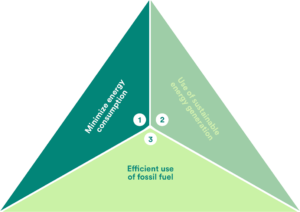
Trias Energetica (original version from 1979)
First step: Reduce the energy consumption at your event
This is definitely the most underestimated measure you can take. Asking the right questions to your creatives, production people and suppliers will have a huge effect on the reduction of the power consumption of your event:
Do we need this?
Can it be done with non-power consuming equipment?
Is there a more energy efficient alternative available?
Can you reduce the time it should be on?
Asking these questions to the right people doesn’t need a lot of technical knowledge, but will have the effect of making people responsible for the energy consumption at your event aware of what energy they are actually using. This awareness will have a positive effect on energy reduction; everyone can see the benefits of cutting unnecessary energy consumption!
Everyone can see the benefits of cutting unnecessary energy consumption
Second step: Use sustainable energy
The second step is a more technical and financial issue. Sustainable or renewable energy is not available everywhere, all the time. The most easy way of using renewable energy is to make use of a grid connection and buy preferably locally produced renewable energy. The infographic shows how renewable energy within the electrical grid works; your money goes to the company which generates renewable energy. They are bound to feed the same amount of renewable energy to the grid as they have sold to their customers.
If there is no grid connection available at your event, or the grid connection is not sufficient, you might use biofuel in diesel generators. The disadvantage of biofuel is that it may reduce emissions of CO2 and (sometimes) NOx, particulate matter etc, but it does not eliminate them. There can also be some issues with verifying that the biofuel has come from a sustainable source and has not, for example, come from crops grown on deforested areas or displaced necessary food crops.
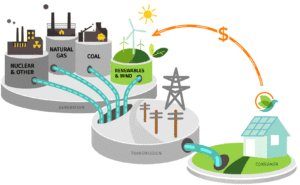
Third step: Efficient use of fossil fuel.
The energy consumption and the maximum power demand of an event is difficult to predict for an organizer. There are many different energy consumers at an event, and not all these consumers (or their suppliers) know what they need. As there is not always a proper overview of all energy consumers, power suppliers will take no risk and over spec the generators. This is to avoid the situation of a diesel generator being overloaded, in such a situation it could stop and shut off the power supply to a whole event area. So now, as a result of this, in practice the diesel generators run on a very low average load during the event. The efficiency of a diesel generator running on a low load is very poor, and this means that there is much more fuel burnt to generate the required amount of energy for your event than is necessary. This means an increase of costs and emissions.
Shortfall of the original Trias Energetica: Targets, legislation and circular festivals
In the European Union, governments have agreed to work towards a full circular economy in 2050. In the path toward this goal, sub goals are set in the Paris Climate and Energy agreement which targets at least 55% Greenhouse gas emissions in 2030.
In the European Union, governments have agreed to work towards a full circular economy in 2050
The goal for more and more event organisers is to organise a circular event and in 2019 the international Green Deal Circular Festivals started. The Green Deal’s goal on energy is “In a circular festival, all energy produced and consumed by festival participants during the build-up, show and breakdown comes from renewable sources”.
So, even the efficient use of fossil energy is no longer an option. The first 2 steps of the Trias Energetica are a good way to come to an emission free, renewable energy driven event. However, the third step still allows you to use non-emission free, non-renewable energy at your event. The model is only helping you to reduce this. The original Trias Energetica is therefore not suitable to achieve a truly circular event.
Renewable Trias Energetica
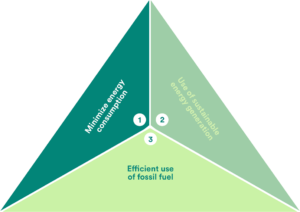
Renewable Trias Energetica (updated version January 2021)
First step: Reduce the energy consumption at your event
The first step of the Renewable Trias Energetica remains the same as the previous Trias Energetica: Reduce the energy consumption at your event.
Second step: Use onsite renewable energy sources.
The use of onsite generated renewable energy is currently a big challenge. This involves onsite generated solar and wind power. Both solar and wind power are not easy to use on a large scale in a mobile application. However, we can more and more integrate (particularly) solar panels on other structures (like solar roofs on containers and tents). As these onsite renewable power solutions depend on the actual weather conditions, combination with battery storage is essential. As affordable temporary solar and wind energy are still not widely available yet, it’s often not possible to replace the entire power for your event with on site produced renewable power. Instead, you can adopt a fade in/fade out principle (let the amount of on site produced renewable energy grow, whilst decreasing the contribution of non-renewable energy). At a certain point, when the onsite generated renewable energy exceeds the consumption of the event, this can be termed an ‘energy regenerative’ event.
A recent example of on site renewable energy generation is the pilot of the PowerVibes project called GEM-tower
The GEM tower consists of an extendable tower with battery storage located in the base of the tower. In the tower there are colourful LSC solar panels (Luminescent Solar Concentrator panels) and there is a wind turbine on top of the tower. There is also an input for flexible solar panels (‘Solar Canvases’), any number of which can be placed on any suitable surface at an event (like containers or tents etc.) and there is an input for an external power supply such as a grid connection, (bio) diesel generator or a hydrogen fuel cell.
No alt text provided for this image
At the Praha Zari festival in Prague (September 2020) the GEM-tower produced 23% of the total energy consumption of the Letni Poloha and Kefir Festival area. Those 2 areas were smaller areas of the entire event, but nevertheless it is a substantial part as a first start.
No alt text provided for this image
The remaining energy (grey coloured) was supplied by a local available grid connection. Another great example is the installation of a solar carport installation on the parking area of the Lowlands festival (Biddinghuizen, The Netherlands):
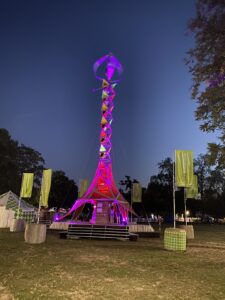
Car parks and solar farm
Construction of the solar car park in the car park area, with 90,000 solar panels, one of the largest in the world, with a maximum capacity of 35 megawatts. This solar car park is an example of a versatile use of space, bifacial solar panels will be used and no parking space will be lost with the construction.
On this site they receive tens of thousands of visitors to events, so it is good to inspire these visitors by generating sustainable energy and applying parking in a great way. “As promoters, we want to contribute to combating climate change and in this way we hope to be a source of inspiration for our visitors, no matter how small, to contribute to sustainability.”
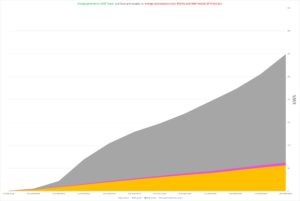
The parking area occupies a total of approximately 35 hectares and offers space for 15,000 cars. The installation will generate renewable electricity equivalent to the energy requirements of 10,000 homes or the energy used for about 100 festival weekends a year. So with this project, the Lowlands festival will be one of the first energy regenerative (large) outdoor festivals in the world!
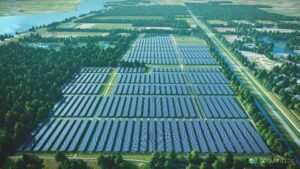
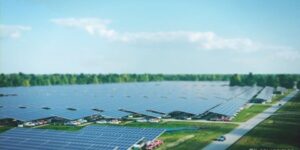
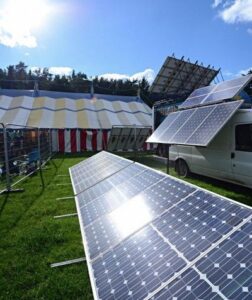
The completely solar powered festival: It might seem that a completely solar powered festival is a nice goal for the future. However, this is a goal that was already reached by the Croissant Neuf Summer Party (CNSP) in the UK over 10 years ago. Run by the same people who also run the completely solar powered Croissant Neuf area at Glastonbury Festival, CNSP was a unique festival for 3,500 people that ran every year from 2007-2013.
Pioneers of energy efficiency and renewable energy, the organisers of the festival applied, to great effect, the first 2 principles of the Renewable Trias Energetica – Reduce Energy Demand & Use Onsite Renewable Energy.
The festival was set in a remote location in Wales with no grid connection and used no diesel generators, but it still boasted 2 main stages with full audio and lighting rigs, 2 bars, numerous self sufficient traders (including 2 sit down cafes), workshop tents, kids area, 3 camping fields and all the usual site infrastructure such as festoon lighting, backstage dressing rooms and offices, toilets and showers etc.
By using only energy efficient equipment and removing the need for electrical power where it was not essential, it became possible to run the entire site from a total of around 18kW of solar power, coupled to a total of 270kWh of battery storage units. The result was a festival with no noisy generators, zero emissions, and that still had power where it mattered to put on a great party for thousands of happy people!
Third step: Use remote (off site) generated renewable energy.
If you want to use renewable energy which is not generated on site at the event, you’ll need to transport this energy to the event area. This can be done through a cable (grid connection) or the renewable energy can be stored in batteries or in hydrogen and transported to the event site.
Grid connection: there are many ways to get access to the grid at your event.
- Regular low voltage connections (230/400V) which might be in place for other purposes but can be used for the event (mostly from 3 kW up to max 250 kW per connection).
- High voltage connection (10-20 kV) with a permanent or temporary transformer to 400V (mostly with capacities from 250 kW up to 1250 kW per connection).
- Special connections like EV charger points which under certain conditions can be used for other applications like events.
Transportation of energy if no grid connection is available:
- Use dedicated batteries charged with renewable energy. If you don’t use batteries for peak shaving, but only the stored energy, you need to check if the transport of the batteries does not lead to more emissions than the emissions of the alternative (e.g. transport and use of a diesel generator) .
- Use batteries of electrical vehicles (from visitors, crew or suppliers). If you know how much energy (a specific part of) your event consumes and you know how much energy the EV owners want to provide to the event, you can calculate how many EV’s you need.
- Use fuel cell generators to convert hydrogen which is supplied to the event into electricity, or use hydrogen fuelled vehicles (from visitors, crew or suppliers) to generate the required power for certain areas of the event. In order for this to be truly circular, you should take care to verify the source of the Hydrogen is not from fossil fuels.
A recent example of transportation of renewable energy to an event venue when there is no grid connection available is the UIA project of the municipality Breda called AirQon. In this project a community of EV drivers and EV fleet owners has been build. Within the project bi-directional EV charges suitable for off-grid applications are developed. With this technique, EV’s which can can be discharged via their charge connection (like Nissan Leaf) will be used to supply power to (parts of) the event. If an event organiser wants to make use of the AirQon power, the community will be activated. Members who are interested to visit the event will get an incentive if they will come by EV and are prepared to “donate” some power to the event.
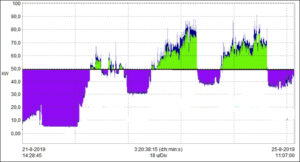
A calculation tool based on the Smart Power Plan is developed and will be used to match the power and energy requirements of the event with the number of available EV’s. Based on the information of the EV (battery capacity) and the travel distance from the EV owner to and from the event, the tool will provide information about the maximum energy which can be used per individual car. This info is used by the bi-directional chargers, so the EV driver is sure that there is enough energy in the battery left to safely drive home. One of the pilots of AirQon was the provision of power to the innovative, sustainable pop-up restaurant The Greanery. The picture in the header of this article shows this pilot.
By using a Smart Power Plan based on an extensive inventory of actual consumer equipment, you can reduce these inefficiencies and save up to 40% of your budget and emissions. With the Smart Power Plan, the expected load profile of the event can be calculated. By using a combination of the available energy sources and battery storage, the optimal power supply system for the event can then be designed.
Figure of peak shaving of the energy needs of an event, showing the available grid connection (50 kW) and additional energy provided by a battery. Purple – energy from the grid is stored into the battery. Green – energy from the battery is added to the grid connection to meet the actual event power demand.
Examples of the use of remote generated renewable energy at events
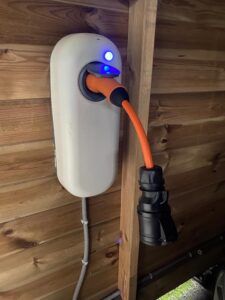
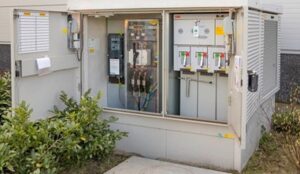
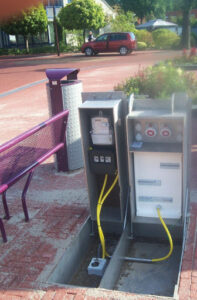
Examples of transported energy to events
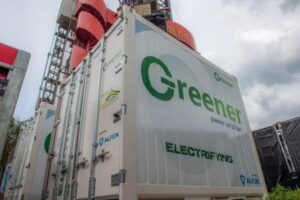
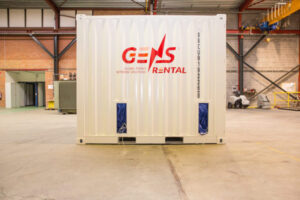
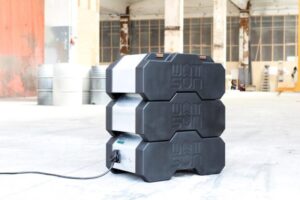
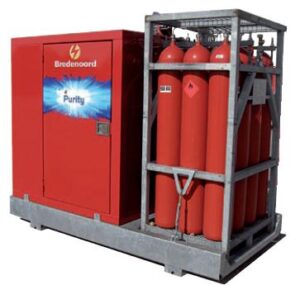
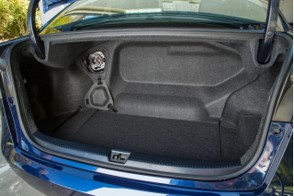
Emission free, renewable energy at your event
By shifting from Trias Energetica to the Renewable Trias Energetica, a 100% emission free, only renewable powered event becomes realistic. The Renewable Trias Energetica principles should be based on a systematic and detailed approach as determined in a Smart Power Plan.


